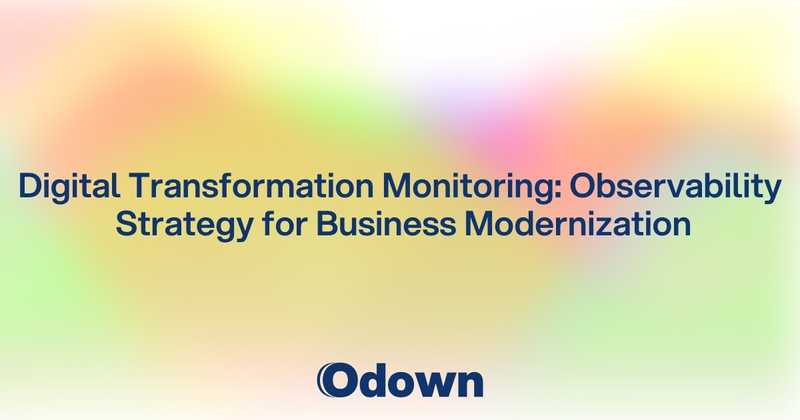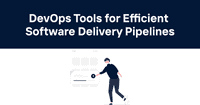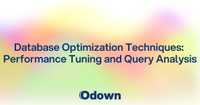Digital Transformation Monitoring: Observability Strategy for Business Modernization
Your company just launched a major digital transformation initiative, moving critical business processes from legacy systems to modern cloud platforms. Three months in, you're experiencing intermittent performance issues that didn't exist with the old systems, but your traditional monitoring can't pinpoint whether problems stem from new applications, legacy integrations, or the complex interactions between old and new technologies.
Digital transformation creates monitoring challenges that don't exist in stable, mature environments. You're simultaneously managing legacy systems, implementing new technologies, and creating hybrid architectures that bridge decades of technology evolution. Traditional monitoring approaches designed for static environments often fail during periods of rapid change.
The complexity multiplies when digital transformation affects customer-facing systems. Users don't care whether performance problems come from your 20-year-old mainframe or your brand-new microservices architecture---they just want applications that work reliably and perform well.
Organizations that succeed in digital transformation implement monitoring strategies that provide visibility across hybrid environments while supporting rapid change. Comprehensive monitoring platforms help organizations maintain reliability during transformation by providing unified visibility across traditional and modern systems.
Monitoring in Digital Transformation: Supporting Business and Technology Change
Digital transformation monitoring must support both technological modernization and business process changes that often happen simultaneously.
Business Process Modernization Tracking
Digital transformation typically involves reimagining business processes alongside technology upgrades:
Digital workflow performance monitoring tracks how new automated processes perform compared to manual processes they replace. Digital workflows should improve efficiency, but monitoring helps identify where automation creates new bottlenecks or user friction.
Customer journey digitization tracking measures how customers adapt to new digital touchpoints and self-service options. Successful digital transformation improves customer experience, but poor execution can frustrate customers and damage business relationships.
Employee productivity measurement during technology transitions helps identify where new systems improve or hinder workforce efficiency. Technology changes that reduce employee productivity often indicate training needs or system design problems.
Technology Modernization Observability
Modernizing technology stacks creates monitoring requirements that span multiple architectural approaches:
API-first architecture monitoring tracks the performance and reliability of APIs that connect modern applications with legacy systems and external services. API performance often becomes the bottleneck in digital transformation initiatives.
Microservices performance monitoring provides visibility into distributed applications that replace monolithic legacy systems. Microservices architectures require different monitoring approaches than traditional applications.
Event-driven architecture observability tracks message queues, event streams, and asynchronous processing that enable real-time business operations. Event-driven systems can fail in subtle ways that traditional monitoring might miss.
Change Management and Rollback Readiness
Digital transformation involves continuous change that requires monitoring systems capable of supporting rapid iteration:
Feature flag and gradual rollout monitoring tracks how new functionality performs during controlled releases to subsets of users. Gradual rollouts help minimize risk, but they require monitoring that can distinguish between different user experiences.
A/B testing performance analysis measures how different approaches to digital transformation affect user experience and business outcomes. A/B testing provides data-driven guidance for transformation decisions.
Rollback readiness monitoring ensures that organizations can quickly revert to previous systems or configurations when new implementations don't perform as expected. Rollback capability reduces transformation risk and builds confidence in change initiatives.
Legacy System Monitoring: Bridging Old and New Technology Stacks
Digital transformation rarely involves complete replacement of existing systems. Instead, organizations must create hybrid environments where legacy and modern systems work together effectively.
Legacy-Modern Integration Monitoring
Integration points between old and new systems often become performance bottlenecks and reliability risks:
Integration middleware performance monitoring tracks how effectively systems like enterprise service buses and API gateways connect legacy applications with modern services. Integration middleware often becomes the weak link in hybrid architectures.
Data synchronization monitoring ensures that information remains consistent between legacy databases and modern data platforms. Data inconsistencies can cause business process failures that are difficult to diagnose and resolve.
Protocol translation monitoring tracks how effectively systems convert between different communication protocols and data formats used by legacy and modern applications. Protocol translation errors can cause subtle data corruption or communication failures.
Legacy System Performance Optimization
Existing systems often must handle new workloads and integration requirements during digital transformation:
Legacy application scaling monitoring tracks how well existing systems handle increased load from new digital channels and processes. Legacy systems might need optimization or replacement when digital transformation changes usage patterns.
Database performance under new access patterns monitoring helps identify when legacy databases struggle with queries and data access patterns introduced by modern applications. Database bottlenecks often limit digital transformation success.
Mainframe and core system monitoring ensures that critical legacy infrastructure continues operating reliably while supporting new digital initiatives. Core system failures can bring down entire digital transformation initiatives.
Technical Debt Management
Digital transformation often reveals technical debt that must be managed carefully:
Code quality and security assessment monitoring tracks the health of legacy systems that must continue operating during transformation. Technical debt can create security vulnerabilities and reliability risks.
Dependency mapping and risk assessment helps organizations understand how legacy systems support business operations and prioritize modernization efforts. Some legacy systems might be more critical than initially understood.
Sunset planning and migration readiness monitoring tracks progress toward eventual replacement of legacy systems. Sunset planning helps organizations balance immediate digital transformation needs with long-term modernization goals.
Cloud Migration Monitoring: Ensuring Performance During Transition
Cloud migration represents a major component of most digital transformation initiatives, requiring specialized monitoring to ensure successful transitions.
Migration Phase Performance Tracking
Cloud migrations typically happen in phases that require different monitoring approaches:
Pre-migration baseline establishment captures performance metrics for existing systems before cloud migration begins. Baseline measurements provide comparison points for evaluating migration success.
Migration process monitoring tracks data transfer, application deployment, and configuration replication during cloud migration activities. Migration monitoring helps identify problems before they affect production operations.
Post-migration validation ensures that migrated systems perform as expected in cloud environments. Performance validation should happen immediately after migration and continue during stabilization periods.
Hybrid Cloud Architecture Monitoring
Many organizations operate hybrid environments during migration transitions:
Multi-cloud performance monitoring tracks applications and data that span multiple cloud providers or combine cloud and on-premises infrastructure. Multi-cloud architectures create complexity that requires specialized monitoring approaches.
Network connectivity and latency monitoring becomes critical when applications span cloud and on-premises environments. Network performance often determines the success of hybrid cloud architectures.
Data replication and backup monitoring ensures that critical business data remains protected and accessible during cloud migration processes. Data loss during migration can cause serious business disruption.
Cloud Cost and Resource Optimization
Cloud environments provide new opportunities for optimization that require monitoring:
Resource utilization and cost optimization monitoring helps organizations avoid over-provisioning cloud resources while ensuring adequate performance. Cloud cost optimization requires ongoing monitoring and adjustment.
Auto-scaling performance monitoring tracks how effectively cloud applications scale resources based on demand. Poor auto-scaling can cause both performance problems and cost overruns.
Cloud service dependency monitoring tracks how applications use cloud-specific services and identifies potential vendor lock-in or reliability risks. Cloud dependency monitoring helps guide architectural decisions.
Digital Experience Monitoring: Customer Journey and Engagement Tracking
Digital transformation success ultimately depends on improving customer experience, requiring monitoring that tracks user journeys and engagement across digital touchpoints.
Customer Journey Performance
Digital transformation often creates new customer touchpoints that require comprehensive monitoring:
Omnichannel experience monitoring tracks customer interactions across websites, mobile apps, chatbots, and other digital channels. Consistent experience across channels is essential for digital transformation success.
Customer onboarding performance monitoring measures how effectively new digital processes help customers get started with products or services. Poor onboarding experiences can undermine digital transformation benefits.
Self-service platform monitoring tracks how customers use digital self-service options that reduce support costs and improve convenience. Self-service platform performance affects both customer satisfaction and operational efficiency.
User Engagement and Behavior Analysis
Understanding how users interact with digital platforms helps optimize transformation initiatives:
Feature adoption tracking measures how quickly and extensively customers use new digital features and capabilities. Low adoption rates might indicate user experience problems or training needs.
User satisfaction correlation analysis links technical performance metrics with customer satisfaction surveys and feedback. Correlation analysis helps prioritize technical improvements based on customer impact.
Digital abandonment and drop-off monitoring identifies where users leave digital processes before completion. Abandonment analysis helps optimize conversion rates and user experience.
Personalization and Recommendation Performance
Modern digital experiences often include personalization that requires specialized monitoring:
Recommendation engine performance monitoring tracks how effectively personalization systems improve user engagement and business outcomes. Recommendation systems can significantly impact conversion rates and customer satisfaction.
Content delivery and personalization monitoring ensures that customized content loads quickly and displays correctly for different user segments. Personalization systems can introduce performance complexity that requires careful monitoring.
A/B testing and optimization monitoring tracks experiments designed to improve digital experience and business outcomes. Continuous optimization requires monitoring that can measure the impact of changes on user behavior and business metrics.
Digital transformation monitoring requires understanding both technical performance and business impact across evolving architectures. Monitoring ROI calculation strategies help organizations justify the monitoring investments needed to support successful digital transformation initiatives.
Ready to ensure your digital transformation maintains reliable performance across legacy and modern systems? Use Odown to monitor the websites, APIs, and digital platforms that form the foundation of your business modernization efforts while providing the uptime visibility needed for successful transformation.



